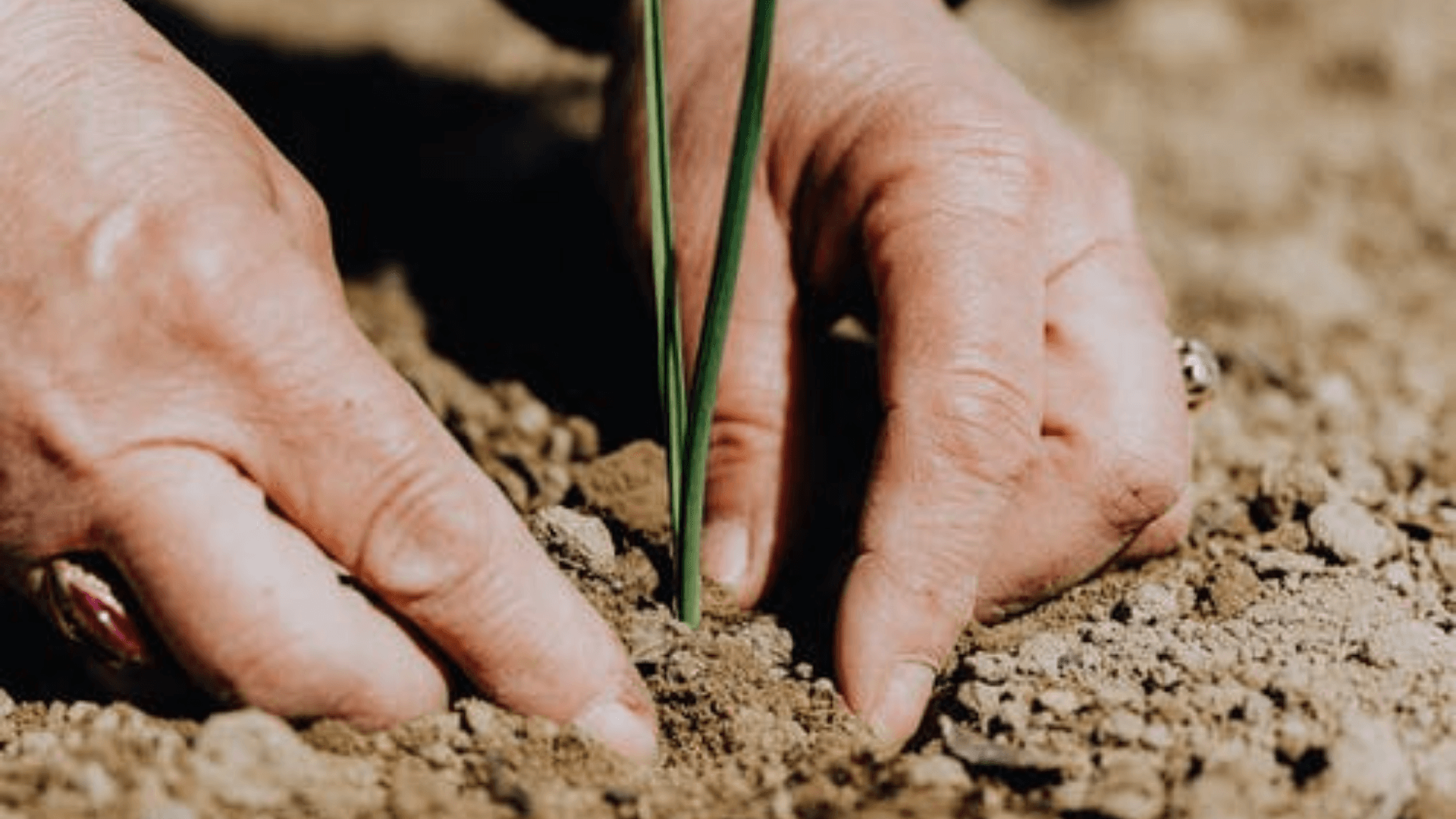Wondering What to Do With Tree Stump In Front Yard? 11 Amazing Ideas to Try Out
Last Updated on June 28, 2020 by Duncan
After removing a tree, you are left with a stump. Lets us be honest, there is nothing sexy about it. It’s unsightly, attracts insects, and you or your kids can stamp on it and get hurt.
Many homeowners rush to remove the stump, but as a creative, you don’t want to be like everyone else—you want to create something extraordinary.
Are you wondering what to do with tree stump in front yard? There are plenty of things you can do with it. Here are 11 of them:
1. Welcome fairing into your front yard
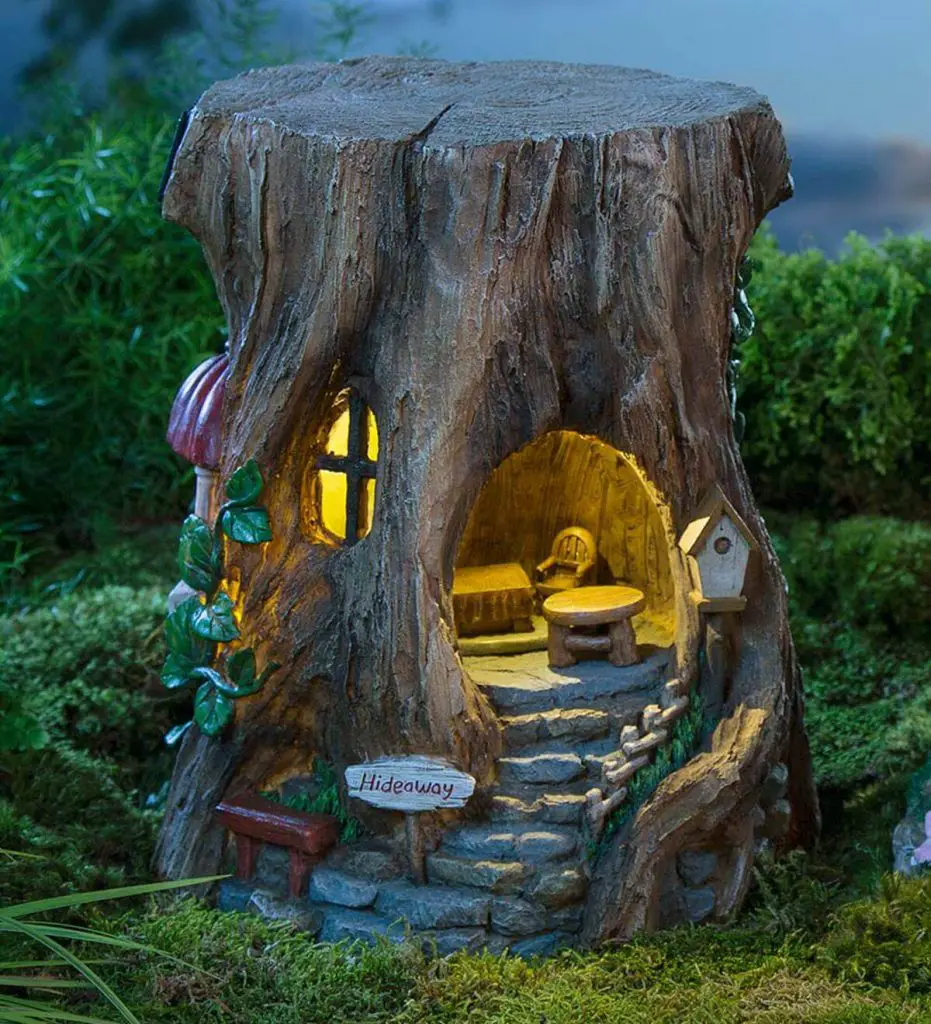
If you have a large stump, you can convert it into an eye-catching gnome home. The beauty of it is that it’s extremely easy to do it.
Add a door and windows to the stump, a path, a doorstep, some paintings, and you have something you will not only be proud of, but one that will always be a conversation starter.
To create an illusion, the stump houses a family of fairies, have a small doorway. Also, create a walking path made from acorns, twigs, or gravel.
When it comes to the windows, you can make them from twigs or pieces of mirrored glass. They can run up the stump or place them in a specific area. It also depends on the theme of the gnome home.
When building the home, remember that it all lies in the details. So have a flat rock in the doorway that you use to create a patio. You can also create a winding stairway around the stump that leads to a hidden door.
Plant mosses, small plants, or ground covers such as ajuga. Once you are done, populate the home with whimsical inhabitants. If you got kids, move the fairies around to create evolving storylines.
2. Create a focal point in your front yard with stump planters
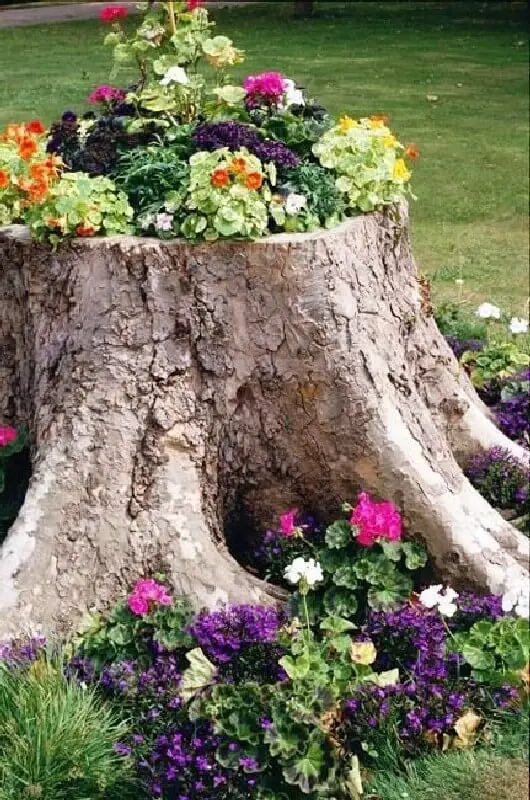
You can design the tree planter anyway you want. The most common design is the hollow stump planter, where you simply plant directly into the stump itself.
To create this planter, you need to hollow the stump using an ax, mattock, or any other sharp object.
Unless you are looking for a small planting hole, have at least 2-3 inches around the perimeter. Remember also to include drainage holes that prevent root rot and extend the life of the stump.
Once you are done, you can opt to plant directly on the stump hole, or place a container into the hole. When planting directly on the hole, first add a layer of compost or potting soil then fill the stump with plants.
You can plant anything in the holes. If you want to draw attention to the stump, plant colorful flowers in the holes, and you will have beautiful blooms.
Do you live in dry areas? Succulents are your go-to materials. You can plant seedling or nursery plants. You can even sow seeds directly in the stump planter. It’s solely on you!
The only thing you need to ensure is the plants you go with are ideal for your environment. If you live in dry areas, you want tough plants that will withstand the heat. You don’t want plants that will dry out after a few weeks, do you?
3. Make a wooden table from the tree stump

Transforming your tree stump into a table not only improves the look of your front yard, but it also provides you with an excellent place to have lunch and dinner.
Start with making the cut as flat as possible. Depending on the thickness of the stump, you can cut the stump at two different levels to create a two-tiered table.
You can use any material for the tabletop as long as it complements the look of the front yard. If looking for a natural look and don’t want to paint the table, use cedar, redwood, or teak.
If you feel you should paint the tabletop, use a high-quality primer before painting with a finish coat. Since the table will be outdoors all the time, you may have to apply multiple coats of paint.
For best results, use semi-gloss paint made from wood. Before you apply a second coat, ensure the first coat has dried out completely.
You should then drill pilot holes and use large galvanized wood screws to attach the tabletop to the stump. If necessary, use shims or wood wedges to level the tops.
To create additional levels, use a chainsaw to cut horizontal notches in the sides of the trunk. Make the cuts deep and narrow, so they hold the rounds tightly into place.
4. Turn a dead stump into a board game

You will be literally bringing things to life by turning a dead stump into a board game. The stump shouldn’t be too tall that the kids can’t reach it. Begin with making the stump surface as flat as possible.
You should then paint a kick tack toe or checkerboard on top of the surface and collect smooth garden stones as player pieces. To give your game a theme, paint the rocks to your desired color and design.
You can paint the rocks completely yellow (bumblebee) and red (ladybug). Are you a patriot?
Go with a patriotic theme and paint half the rocks blue with white stars and the other half red with white strips, giving the stones a flag-like appearance.
If you love the traditional design of Xs and Os, go with single colors and paint half the rocks one color and the other half the other color. In the end, use your pen or paint to design the legendary, X’s and O’s on all the rocks.
Once you are done, apply a coat of exterior sealer at the top of the stump to preserve the game board, then pull a few lawn chairs and let the games begin!
5. Turn your tree stump into an avian spa
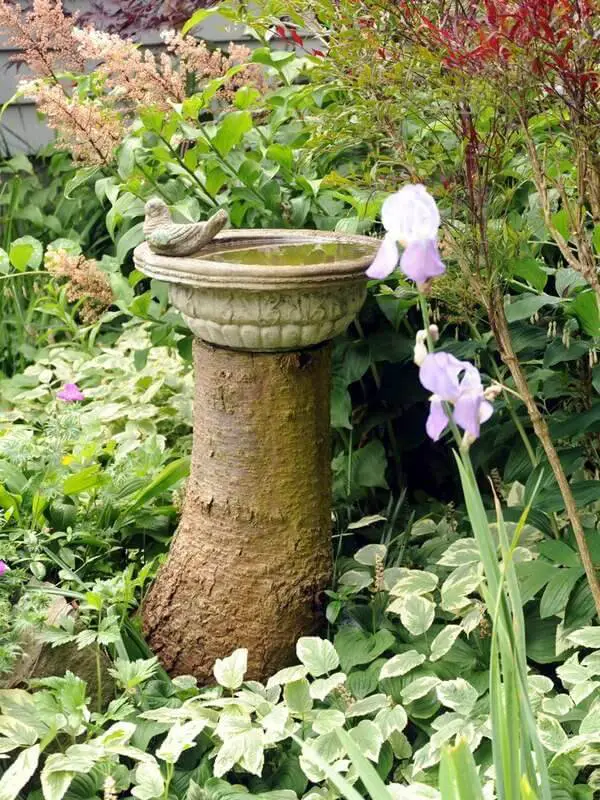
Are you a bird person? You should know that birds love a ready source of water, and when you put up one for them, they will happily drop in and out of your home.
Before you begin constructing the birdbath, think what an ideal birdbath should be like.
It should be in a safe place where predators can’t hide, should be in an area where the bird can easily escape a predator, should be low to the ground, no deeper than 2 inches, have a rough bottom for secure footing, outfitted with a staging stick for easy scanning of the surrounding area, and regularly cleaned and refilled with fresh, clean water.
To create the bird spa, begin with cleaning the tree stump with a hose to eliminate any debris or dirt that might be on the surface. This act will also remove any fungus that might be growing on the top side of the stump.
You should then dig out the top of the stump that will be the birdbath. Remove the inner wood with a chisel, hammer, and drill.
Make a bucket of cement that will make the bird bath’s bowl then put a little of it into the hole that you created in the tree stump.
Using a trowel, smooth, and spread the concrete to make the bowl. Continue smoothing and spreading the concrete until you complete the bowl. For ideal results, ensure that the concrete covers the bottom and sides of the depression.
Once you are done, let it set then fill it with water after a day (24 hours).
6. Turn your stump into a sculpture

A chainsaw in the hands of a sculptor can turn an ugly stump into a work of art. If you have the skills, you can sculpt by yourself, but if you are like other homeowners, hire a professional.
You can make a sculpture of anything. Although, soft maple carves the best, you can carve any tree regardless of its nature.
7. Transform stumps into lamps
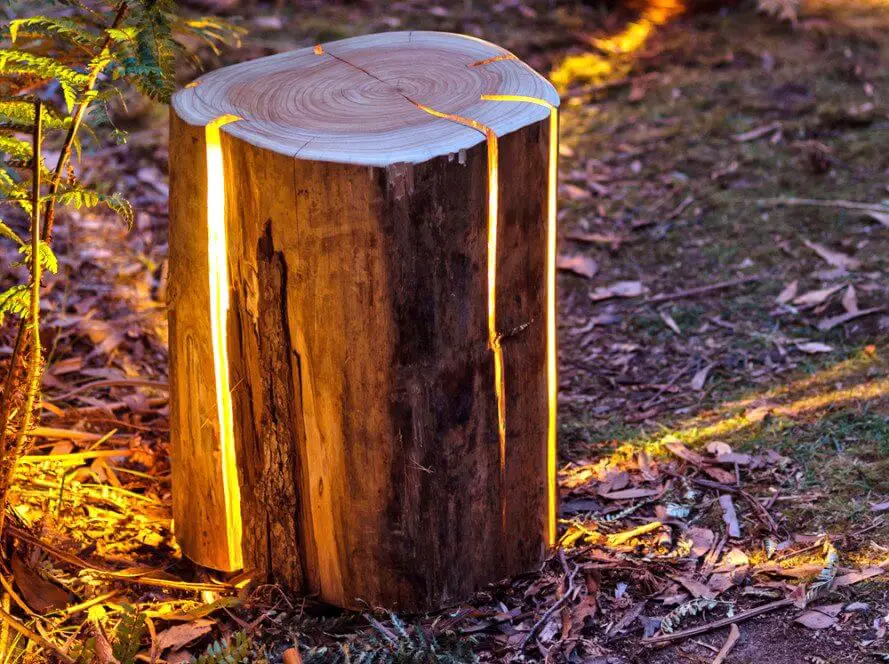
This idea was brought to life by Duncan Meerding, a legally blind Tasmanian furniture designer. Duncan transformed an ordinary tree stump into a beautiful weather-resistant lamp that you can also use as a table and stool.
To make this beautiful stump, Meerding took advantage of the already existing cracks in the stump, where he placed LED strips in the cracks and fitted them into a lamp.
If you need extra lights on your front yard, you can draw inspiration from Meerding’s work and place lights in your stump.
You can use any size of the stump and use Led lights of any color. If you have the skills, you can do the work by yourself, but for best results, let an expert handle it for you.
8. Turn the stumps into a front yard walkway

Pavers are everywhere, but if you want to stand out and maintain a natural look to your home, lay wood slices from the tree stump on the pathway.
Begin the project by preparing the area where you want to create the pathway. You can use a tiller or your hands if preparing a short walkway.
You can leave the surface as it is but to increase the lifespan of the slices, dig below the surface 3-4 inches and fill the surface with compacted stone. The water will drain away from the slices hence giving them a longer life.
Using a saw, cut the tree stump into wooden discs of about 2” – 4” thick. To protect the discs from water, ants, termites, and other insects, treat them with linseed oil.
Begin with sanding the surface of the bare wood with a 120 grit sandpaper to make it easy for the oil to penetrate the surface.
You can apply plain linseed oil, but for better penetration, mix the first coat with a mild solvent such as odorless thinner or citrus solvents. Use a brush, cloth, or roller to apply the first coat.
Three coats will provide maximum protection. After the last coat has dried out completely, apply a light hand polish to enhance the satin finish and smooth the texture.
You should then lay the discs along your string line, spacing them at a comfortable distance that works for you and your family. To give the path a uniform look, level each disc using concrete.
To increase the lifespan of your walkway, use hardwood slices from walnut and ash.
If you don’t have a saw, you can rent one from your local convenience store. Take care when handling the saw as you can easily hurt yourself.
If you aren’t a handy person, hire an arborist to cut the slices and a landscaping contactor to lay the pieces.
9. Create a natural playground for your kids

Got kids in the house? You know how energetic and active they are, right? To keep them busy, get stumps of different heights that will challenge the kids to walk, skip, crawl, climb, or even jump.
The kids can even tap on the stumps, which is entertaining.
When cutting the stumps, ensure they don’t have sharp edges that can hurt the kids. Remember, insects can infest the wood, so you should treat it.
To avoid giving your front yard a confused look, designate a special place to place the stumps. One of the best places is under a large tree.
10. Create an aged moss stump
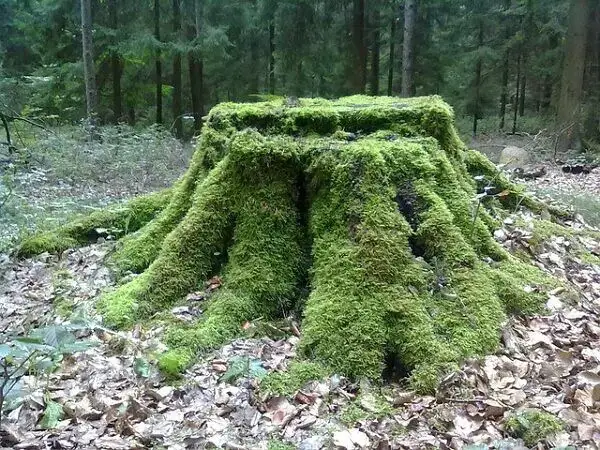
Moss has been around since the time of dinosaurs. Mosses live on the tree and receive their nutrients from sunlight and water around them. They aren’t parasitic and don’t eat into the bark or exposed wood.
You can use moss to make a stump growing in a dark, humid area, the focal point of the front yard. You can also use it to hide damaged stumps or stumps showing signs of disease.
To grow most on your stump, visit your local plant nursery for the starters. Use wet mud to attach the moss to the stump, and in no time, the greenery will show up and cover the surface.
If you are no longer interested in the moss, you can always remove it anytime. Moss grows in thick mats that you can easily pick and peel off. Wear work gloves when peeling them. If they are stubborn, use a bristle brush.
If removing the moss from a large stump, use a power washer. Remember to wear eye protection and stand at least five feet from the tree. You don’t want to damage your precious stump, do you?
11. Turn the stump into a canvas
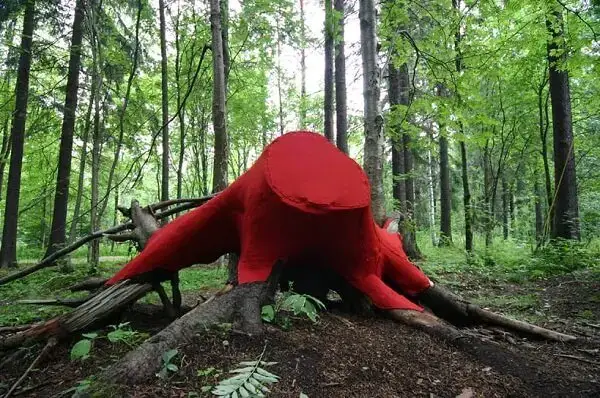
Do you consider yourself an artist? You can create amazing designs regardless of the size of the tree stump.
The cool thing is that you don’t have to create a masterpiece. Create something that is interesting and matches the design of your home.
You can even decorate the stump in patterns or use the mosaic technique to make the stump stylish, unique, and beautiful.
What if you lack creativity and imagination?
If you don’t have the creativity and imagination to turn your stump into something beautiful or you miss your old tree, why not plant a new one? Hire a tree service provider to remove the stump and in place plant another tree.
You can replace the tree with a similar tree that was there before or change things up. Try out another tree you don’t have in your yard such as an apple or cherry. When choosing a tree, go for a fast-growing one.
The new look of the yard might be too appealing that you will be thankful that the old tree is gone.
